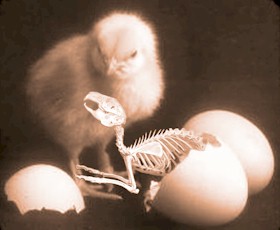
Posted on 03/30/2013 1:14:02 PM PDT by ApplegateRanch
I’m used to ridiculous environmental alarmism, but this one is so far off the mark, it’s comedy. If there’s one thing you NEVER have to worry about, it’s having too few rabbits. Aside from houseflies and cockroaches, there is probably not another species on earth that is more fecund.
All the bunnies decided to leave that extremist liberal state.
We still got lots of them down here!
I just absolutely knew fellow FReepers would have fun with this lunacy, & I was right.
“Thus saith the Hugh Manatee: Hail Holy Darwin: Thou puny Humans shalt not interfere with the Natural Order...except when We, his Holy Priesthood, can force interventions to thwart Holy Darwin, to preserve the Deserving, Cute & Cuddly, Unfit from Catastrophic Non-Interference. The Hugh Manatee hath spoken!”
According to the Wikepedia article, Peter Cottontail was “briefly” known as Peter Cottontail—thereafter as Peter Rabbit.
Get your self a 17B or a 17 Hornet. just a little pop and rabbit stew for dinner.
Yummmmmmeeeeeeee!
Worst still, there are no persistent observable differences between the abundant Eastern cottontail and the New England cottontail. In fact, biologists only discerned a difference between the New England cottontail and the New England cottontail after 370 years of observation, in the 1990s.
Actually, they're one and the same. Peter Rabbit, who was featured in many of the books Thornton Burgess wrote for young people changed his name to Peter Cottontail in The Adventures of Peter Cottontail (New York: Grosset & Dunlap, 1941).
Not too long ago, I read Burgess' Mrs. Peter Rabbit (New York: Grosset & Dunlap, 1919), which chronicles how the moody and depressed Peter sets out from his briar patch on a journey fraught with mortal dangers from predators as well as the jealous father of Miss Fuzzytail, a doe he is pursuing. Each chapter starts out with a quote from Peter, such as "“Who has attentive ear and eye will learn a lot, if he but try.”
Young people today ought to rediscover Peter Rabbit, a far better role model than, say, the bratty and boorish Junie B. Jones, popular among young readers today.
Joel Chandler Harris' "Uncle Remus" books of the 1880's also seem to have influenced Burgess's stories.
“I’m confused. I thought Beatrix Potter wrote Peter Rabbit.”
So did I.
Thanks; so it’s some more slight of hand species fragmentation, where “populations” get redesignated “species” for environazi purposes. Not really surprised. After reading your post, I looked them up.
If New England is running short of rabbits, I’m sure that the Australians would be happy to donate a few.
Next, you’ll suggest they import Bunnies from the Playboy Club?


The article could be clearer. As I looked into the matter, the assertions of those who would preserve the New England Cottontail make sense, at least presuming their truth.
See, one of the very difficult things about wildlife management is that it is natural for environments to progress from one type to another . Humans are very good at recognizing one type of environment and preserving it, but that stability does not recreate natural processes.
In Eastern, humid, temperate zones, there is a natural cycle: 1) Swamps and ponds fill in, becoming meadows. 2) Meadows become fertile lands for shrubs and bushes. 3) Shrubs and bushes provide shelter, fostering the development of trees. 4)Trees grow. 5) Older, larger trees block light from the ground, preventing other plants from growing on the floor, allowing erosion. Huge roots alter runoff patterns. 6) Water collects, and as huge trees finally age, die, and decay, swamps and ponds form.
Apparently, the Eastern Cottontail has larger eyes, and is safer at venturing from shrubs, brush, bushes and new-growth forests into meadows, and the farms which create conditions similar to early post-meadow stages. The New England cottontail thrives only in lands covered by shrubs, bushes, and new-growth forests. (Neither species thrive in older-growth forests, where the forest floor tends to be bare.)
The difference is supposedly in the eyes; NE cottontails have smaller eyes. New England cottontails thrived in the farms of early New England, and as the farms reverted to forest. But Eastern cottontails thrive better in the “fragmented habitats,” including lawns, golf courses, clearances, and nearby woods more typical of modern New England (as well as stream beds, forest edges, etc.)
The authors of this web site CLAIM that the two populations share one habitat without interbreeding. If true, this would be speciation. However, I believe I read earlier that part of how the E Cottontail is destroying the NE Cottontail is by interbreeding it os the distinct traits are absorbed into a larger population.
This is pretty funny. Various enviro memes at battle with each other.
The “natural” (no human intervention) plant succession in New England results in climax forest of deciduous and evergreen trees. Those trees live a really long time and the forest doesn’t change much.
The rabbits live well mainly in “young forest,” a much earlier stage in the progression where the forest starts to come back after disruption by logging, windstorm, forest fire, etc. Prior to the arrival of men the most common of these were fires, which probably often burned for weeks or months before running out of fuel or being put out by rain, “destroying” huge areas of forest in a random way.
When the white man appeared in the area around 400 years ago, the “natural state” of the land had for 10,000 years or more been routinely and regularly managed by fire by the Indians, who burned everything in sight every fall, as a way of ensuring better hunting the next year. What this means is that a new “natural” ecosystem had developed, dependent on this regular semi-controlled burning to maintain itself. This was of course in addition to the natural method of potentially massive completely uncontrolled fires, as the Indians had no way to put out big fires.
Today the “natural” method of resetting the plant succession of uncontrolled fires, and the “sorta-natural” (if you classify Indians as a species of wildlife as most liberals do) of sorta-controlled burns are both prohibited and controlled. So of course any land not cleared or built on eventually reaches the climax forest stage and stays there. Animals dependent on young forest become more rare or die out entirely.
The truly hilarious part is that occasional clear cutting of the forest for lumber products would simulate the natural processes of fire, windstorm, etc. nicely, and reset the plant succession. But we can’t have that because logging is eeeevil.
So, IOW, the jury is still out on speciation.
In any case, humans are supposed to freeze the natural progression, to preserve a species/subspecies from natural decline due to the natural evolution of its habitat.
In doing so, how many other species are adversely affected by artificially freezing or even reversing the cycle?
I know, we already interfered with the cycle by clearing and planting the land to farms in the first place, BUT the same people were complaining about that, as in ‘deforestation’, which is one reason those lands were allowed to revert.
Can’t have it both ways. At least when it was honest farmland, it produced products, jobs, and generated taxes; then it went—at taxpayer expense, in many cases—into ‘reserves’, by what ever catchy name; now they want more tax money to unreserve the reserves without actually farming the land.
As others mentioned: Agenda-21 may be involved, with a “threatened” bunny the trigger, a-la northern spotted owls in the Pacific states & logging: bad, repudiated science, but the mills are still gone.
That’s the thing: you CAN’T freeze natural progression. This is also a critical problem in Western forest management, which has been largely based on fire suppression. The problem is that fires are a critical part of natural progression in the West, where they rejuvenate the forests. Without them, the forests are ALL progressing to ultra-old growth and peat & bog stage, which are ironically very poor environments for nearly all mammal and bird species.
Actually, one of the great ironies is that white men arrived in an environment which had been for centuries highly managed by Indians, but an apocalyptic plague had just wiped out Indian civilizations. Henry Hudson reported Manhattan Island was thick of Indians, whose campfires darkened the evening sky. By the time the pilgrims arrived, there were mere thousands. Thus, settlers had no clue WHAT the natural progression looked like; what they found was quite unnatural, little did they realize.
Disclaimer: Opinions posted on Free Republic are those of the individual posters and do not necessarily represent the opinion of Free Republic or its management. All materials posted herein are protected by copyright law and the exemption for fair use of copyrighted works.